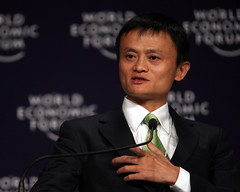 Image by Getty Images via @daylifeThe Re-wired group and I were talking on a call today about some of the changes taking place in the China social media space, and how they could herald changes to e-commerce, advertising and marketing here in the United States. When it comes to social tech, and the social networking that happens on platforms like Sina weibo, Tencent's QQ IM service, and with companies like Alibaba's alipay service, China often appears to have a leg up. Those companies are led by aggressive first movers, who have a lot of government support.
Image by Getty Images via @daylifeThe Re-wired group and I were talking on a call today about some of the changes taking place in the China social media space, and how they could herald changes to e-commerce, advertising and marketing here in the United States. When it comes to social tech, and the social networking that happens on platforms like Sina weibo, Tencent's QQ IM service, and with companies like Alibaba's alipay service, China often appears to have a leg up. Those companies are led by aggressive first movers, who have a lot of government support.I brought up the fact that it looked like Alibaba CEO Jack Ma's aggressive push to tie services into a social e-commerce bundle looked like a big play for changing the way consumers shop and how consumers are marketed to. It seems a simple gesture, but Bob Moesta and Chris Spiek pointed out a few things, and I think they are worth bringing up today.
Bob said that the aggressive push to use social media technology was a big sign that China didn't have to spend millions (or maybe billions) on traditional forms of advertising. If the social layer is well embedded, then advertising and marketing becomes a very granular enterprise. He said it is about "building influence through credibility and bypassing thirty years of marketing and advertising and selling with underlying technology." What that means: if you can find the people that influence their friends the most to purchase goods, why do you have to come up with a million dollar advertising narrative? Just give them the product, make them feel they are part of a community, and let them make up the rest.
Chris added, cogently, that this technique obviously "lowered the advertising and selling costs. You can cut that in half becuause you are getting product to market through people, not through advertising, per se."
What Chinese social media companies and what I will now begin to call social e-commerce companies are doing is creating the next layer of seeing who is influencing what product purchase in what category. As Bob said on the call, "It's about measuring the direction and magnitude of specific topics. It's really about making connections, so you you know each other, you must influence each other. Your friend in one area may influence you in one way, but then again, your other friend might influence you in other areas."
It kind of turns the world of advertising demographics on its head. You can't say anymore, if the above is true, that a person aged xx to xx with two cars, living in xxx city will live a lifestyle closely resembling other males in that area. You now have to drill down into the relatinoship. So what job does advertising and marketing begin to do? It begins to be about researching your life history, not researching what you own and where you shop, what you like and what you don't like. It's about the emotional narrative that YOU create for your life.
If you want to be a successful advertising team, you need to have people on your team who can research people, who can listen to people, and who can help them tell THEIR stories, not the brand stories. It's not about the brand anymore. It really never was, but what made us think it was? Well, the structure of the media.
The online media and social web structure we have now, as it is currently being used, will unseat the most powerful of advertising and marketing companies, IF they keep doing what they have always been doing --- telling a story about the brand. Stop thinking about the brand.
"There is a calculus that has not been invented yet, but the guy in China will be best positioned to help and know this,"says Bob. But I think it's not even that complicated. Watch how China puts together the tools for listening, and then lets buyers, sellers, marketers and the whole community take care of itself. I close with a quote from Ma, who recently told an annual Alibaba conference in China that he's out to do more than make his competitors Baidu and Tencent, or RenRen stay awake at night. He wants to disrupt the entire financial system.
Mr. Ma also said Alibaba Group wants to take on state-owned enterprises. He said Alipay, an affiliate providing online-payment services that was recently transferred out of Alibaba Group to a separate company controlled by Mr. Ma, already has made a contribution to Internet users by challenging banking services.
“If banks don’t change, we will change banks,” he said. Mr. Ma has been criticized for his decision to transfer Alipay’s ownership because he didn’t seek approval from Alibaba Group’s board of directors, on which Yahoo has a seat. But he has said the transfer was necessary because of restrictions by the People’s Bank of China on foreign control of online-payment companies seeking new licenses would have prevented Alipay from obtaining one, because of Yahoo’s involvement.
image from Fool's Mountain: Blogging for China.



 Posted by
Posted by
 0
comments
0
comments





















